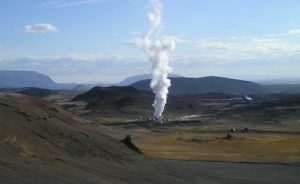Geothermal Energy: The Perfect Renewable
There is a massive frenzy of geothermal research going on, much of it aimed at reducing the obvious obstacles.
There is a revolution coming in geothermal energy. How big it will be and how fast it can grow remains to be seen, but the revolutionary technology is here  now.
now.
We already know about the new technology by name — fracking. But that is fracking for oil and gas, the energy revolution we are already living on, that the greens hate. The geothermal revolution is fracking for heat.
Here is the technical bit. The Earth’s crust we live on is just a thin film wrapped around an 8000 mile diameter molten ball. In some places under the deep ocean this crust is estimated to be just 3 miles or so thick. It is somewhat thicker under the continents but the point remains; it gets hot fast as you drill down into the crust. That heat is geothermal energy.
We have used geothermal energy to make electricity for a long time, but only in tiny amounts. California does the most in the US and its entire generating capacity is about the size of a single large coal fired power plant, about 3000 MW. The whole world is said to just have a minuscule 15,000 MW.The obstacle to doing more has been that useful energy sources are hard to find. You need a confined reservoir of hot water in fractured crust rock. The reservoir size, location and temperature of the water are all determined by nature. Suitable sites have been very few.
Now all of this has suddenly changed. With hydraulic fracturing (or fracking) we can make these geothermal reservoirs where we want them, the size we want them, and where the heat is the temperature we want, especially very hot. This includes the so-called “supercritical” water at 400 degrees C, which is now used in the most advanced power-plants.
Also Read : The Roadmap of Renewable Energy Development in India
It is like the difference between living on wild edibles, if and when you find them, and farming. Fracking for heat is literally a whole new world. Of course, there are still pesky things like cost, feasibility and regulation, but the principal is clear; the technology of revolutionary thermal energy has arrived.
The greens are in a bit of a bind here. Geothermal juice looks like the ideal renewable. Unlike wind and solar, geothermal electricity is constantly available and it is not a land hog. But the greens despise fracking and have labeled it evil. Some States and even whole countries have banned fracking for oil and gas. Whether this applies to fracking for heat remains to be seen, since the fracturing processes are rather different.
How this dichotomy will play out is anybody’s guess. As they say here in the mountains: “What goes around, comes around.” That is, don’t start trouble lest it bite you someplace soft. The greens desperately need geothermal fracking, they just don’t know it yet.
The US Energy Department has a Geothermal Technologies Office and they are understandably optimistic. They project something like 60,000 MW of advanced geothermal juice capacity by 2050. Mind you this is still small, given that our present generating capacity is around a million MW.
The amount of geothermal generating capacity installed by 2050 could be much larger, for one simple reason. It is probably the only way to make wind and solar work.
A number of analysts, including me, have pointed out that electricity storage on the scale needed to power America with intermittent renewables is impossible. But many States have mandated a high level of renewables, even 100% in extreme cases.
This makes geothermal the perfect renewable, because its power can be available whenever the intermittent generators cannot provide the power we need. The more power we want from renewables, the more geothermal capacity we will need. It is that simple. We could be talking about many hundreds of thousands of MW. If the technology works cost wise it might actually be better than unreliable, land grabbing renewables.
Happily, there is a massive frenzy of geothermal research going on, much of it aimed at reducing the obvious obstacles. Searching the engineering and scientific literature for the last five years on the word combination “geothermal” and “research” yields over 100,000 technical articles. That is a lot of research.
So there it is. Geothermal energy is potentially the second fracking revolution. No question the heat is there, thanks to the big molten ball we call Earth. And now we suddenly have the technology to create the infrastructure needed to tap into it. How practical it is, and how acceptable, still remains to be seen. Interesting times lie ahead.
